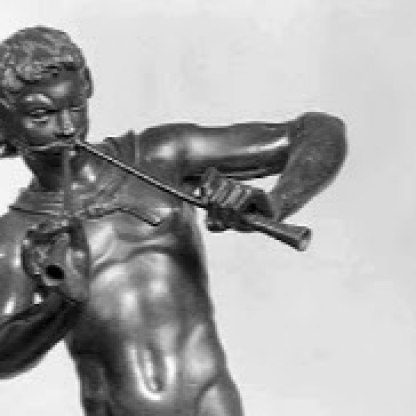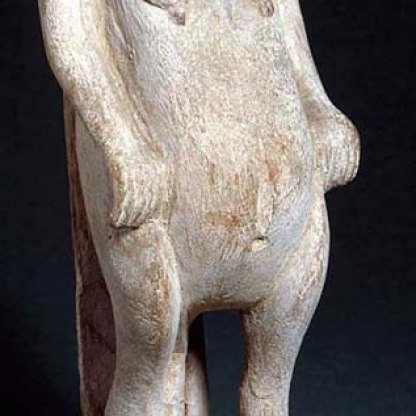Dessert Plate

In December 1837, the Winter Palace in St Petersburg, home to the Russian imperial family, caught fire. The building was looted and 160 pieces of a magnificent eighteenth-century porcelain dinner service made in France for the Empress Catherine II disappeared. By 1840 the pieces had turned up in London, but over the years they have been dispersed to museums throughout Europe and America. This is one of 288 dessert plates from the original ensemble.
The service was a huge undertaking for the Royal Porcelain Factory at Sèvres, and it took three years of intensive work to complete. To cater for sixty guests at her regular state banquets, Catherine ordered eight hundred items, including soup plates, salad bowls, jam pots, ice cream cups and liqueur-bottle coolers. The centrepiece was a figural group consisting of 91 pieces above which loomed a model of the Empress herself, represented as Minerva, the Roman goddess of wisdom, surrounded by the nine Muses.
Catherine was a passionate admirer of ancient Greek and Roman civilisation, an enthusiasm reflected in every aspect of this, the first entirely neo-classical dinner service to be produced at Sèvres. Each item is decorated with heads of pagan deities and scenes from ancient myth or history. The beautiful bleu celeste colouring, seen in the bowl of the plate, was supposed to resemble turquoise stone. The tooled gilt rinceaux – the floral scrolls, left – were inspired by decorations on the first-century BCE Theatre of Marcellus in Rome.
In the centre of the plate, the nucleus around which these classical references abound, is the monogram of the empress herself, left: E II, for Yekaterina, the Russian form of her name, written in flowers and gold, surrounded by a wreath of laurel and myrtle and topped by a golden crown. The monogram occurs on every piece of the service, the diner never being allowed to forget who was responsible for this lavish display of good taste and classical learning.
Catherine was determined that the design of each piece should be original, although based upon the ceramics of antiquity. Through her ambassador in Versailles, Prince Ivan Sergeyevich Bariatinsky, she kept a close watch on the progress of her commission. She was a fastidious patroness. The precise shape of the plates was modified eight times before she was satisfied, and because the more brittle soft-paste porcelain had to be used to carry the blue colour, 3,000 pieces were fired in all, to produce 800 of acceptable quality.
The mythological scenes here depict various exploits of the Greek god Apollo, and are inspired by passages in the Metamorphoses by the Roman poet Ovid. At the lower left, we see the musical contest of Apollo and the satyr Marsyas – detail left. At the top is the gruesome punishment inflicted upon Marsyas for his presumption in challenging a god: he is tied to a tree and flayed alive as Apollo looks on holding his lyre – detail right.
The third scene, left, shows Apollo pursuing the nymph Daphne. She prays to the river god Peneus for deliverance, and he turns her into a laurel tree. Here we see the transformation beginning to take place. As Peneus reclines against a reedy bank, Apollo vainly reaches out to his beloved, whose arms have already become branches.
Between each of these scenes are profile heads. A woman (detail, left), and a man, and the god Pan.
All the figures and heads are painted in grisaille – grey monochrome – against a browny-red background to imitate the appearance of ancient cameos, of which Catherine was an avid collector.
Marks on the bottom of the dish allow us to identify the painters. Charles Nicholas Dodin was perhaps the most celebrated of the figure painters at Sèvres in the eighteenth century. The painter Nicquet was responsible for the flowers – masterpieces of miniature painting. The gilding was carried out by Jean-Pierre Boulanger père and Henri-Martin Prévost. These are but four of the 37 painters and five gilders employed to decorate Catherine's dinner service.
Themes and periods
Data from our collections database
Soft-paste porcelain plate from the Empress Catherine Service, decorated with a bleu céleste ground, 'E II', flowers, and imitation cameos painted in enamels, and lavishly gilt
Soft-paste porcelain decorated with a turquoise (bleu céleste) ground, painting in blue, green, pink, red, and dark reddish-brown enamels, transfer-printed cameo heads painted in reddish-brown enamel, and chased gilding. Circular with a wide rim, and deep well, standing on a fooring with a suspension hole. The dish is heavy for its size. The well has a turquoise (bleu céleste) ground with a central circular reserve framed by a chased gold band. Within it is a wreath made up of branches of laurel and myrtle, tied with a gold bow at the bottom. At the top the branches meet on either side of a gold Imperial crown. Within the wreath is a large script E made up of pink and blue flowers in monogram with 'II' in gold, for Ekaterina II. The rim has white inner and outer borders decorated with small floral sprays separated by husks. Beween them is a broad turquoise band decorated with finely tooled gold foliated scrolls, interupted by three small oval reserves and three larger horizontal oval reserves, each painted en grisaille on a reddish-brown ground to imitate cameos. The small reserves enclose profile heads, respectively of a young woman, a young man, and Pan. The larger reserves enclose mythological scenes from Ovid's Metamorphoses: Apollo and Daphne from Book 1; The competition between Apollo and Marsyas, and the Flaying of Marsyas from Book 6. There is a gold band round the edge, dentilated on the reverse, and a wide gold band round the outer edge of the footring.
William Ward (1817-85) 1st Earl of Dudley; sold Christie's, 21 May 1886, Catalogue of the Splendid Collection formed by the Right Honourable the late Earl of Dudley from the most celebrated cabinets which have been dispersed during the last fifty years which (by order of the Executors), lot 95, 108 guineas. D.M. Currie; Mrs Alistair Currie, sold Christie's, 13 June 1946, Catalogue of Old French Furniture and Sèvres Porcelain . .. p. 7,, lot 55 sold for 78 guineas to F. Partridge for L.C.G. Clarke, MA, Leckhampton, Cambridge (1881-1960).
Legal notes
L.C.G. Clarke Bequest, 1960
Acquisition and important dates
- Method of acquisition: Bequeathed
- Dates: 1961-04-27
Dating
The designs for the service are in the Cabinet des Estampes de la Bibliothèque nationale, Paris, 'Dessins et devis au Service de porcelaine pour l'impératrice de Russie' (B.N., Lf 8 petit folio.)
This is one of 288 plates from a dinner and dessert service of 797 pieces made for the Empress Catherine the Great of Russia (1729-96), which was ordered in 1776, and was despatched to St Petersburg in June 1779. The service was remarkable for its immense size, and the speed with which it was made. It was the first wholly neoclassical service to be made at Sèvres, and the forms were specially designed for it, the plates for example having smooth instead of lobed rims. The use of illusionistic cameos in the decoration reflected the Empress's interest in this aspect of antique art, and innovatory techniques were used to produce them. The outlines of those on the plates were transfer-printed before painting, a technique not normally employed on Sèvres porcelain. For descriptions of the service, see Savill (1988), Dawson (1994), and Peters ( 2005, III). The Fitzwilliam Museum also owns a jug from the service, C.47-1961.
- 18th Century, Late
- Louis XVI
- Production date: AD 1778 : the plate bears the date letter for 1778
Maker(s)
- Sèvres Porcelain Manufactory Factory
- Dodin, Charles Nicolas Painter
- Nicquet Painter
- Boulanger, Jean-Pierre, père Gilder
Note
The designs for the service are in the Cabinet des Estampes de la Bibliothèque nationale, Paris, 'Dessins et devis au Service de porcelaine pour l'impératrice de Russie' (B.N., Lf 8 petit folio.)
This is one of 288 plates from a dinner and dessert service of 797 pieces made for the Empress Catherine the Great of Russia (1729-96), which was ordered in 1776, and was despatched to St Petersburg in June 1779. The service was remarkable for its immense size, and the speed with which it was made. It was the first wholly neoclassical service to be made at Sèvres, and the forms were specially designed for it, the plates for example having smooth instead of lobed rims. The use of illusionistic cameos in the decoration reflected the Empress's interest in this aspect of antique art, and innovatory techniques were used to produce them. The outlines of those on the plates were transfer-printed before painting, a technique not normally employed on Sèvres porcelain. For descriptions of the service, see Savill (1988), Dawson (1994), and Peters ( 2005, III). The Fitzwilliam Museum also owns a jug from the service, C.47-1961.
Place(s) associated
- Sèvres
Materials used in production
Read more about this recordStories, Contexts and Themes
Other highlight objects you might like
Suggested Curating Cambridge products
Sign up to our emails
Be the first to hear about our news, exhibitions, events and more…
.jpg?key=exhibition)







